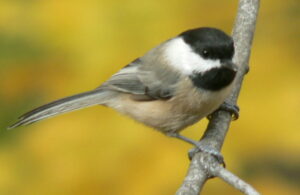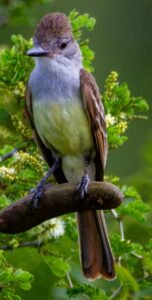The habitat in our yard has changed. Will we see a change in our birds?

Anyone who has an outdoor space, no matter how small, has a habitat. The definition of habitat from the Merriam-Webster Dictionary: The physical environment that provides organisms with their basic needs for survival: food, water, shelter, and space. Our yard’s habitat was a savanna with a wide strip of woodland and our acre of property is a peninsula of a 16 acre lake. With the severe storm we had two weeks ago, this habitat has changed. The savanna remains, but the woodland is gone – it changed into savanna. If you are interested in what a savanna is and how it differs from a grassland and a woodland, click on Articles in the website menu and go to Habitats.
What Cleon and I will be watching for the next year is how this will affect the birds who live here and who also migrate through. Although our woodland was not large, it was connected to a long strip of woodland that ran the entire length of one of the inlets of our lake. This woodland is all full grown hickories and oaks. The understory is sassafras, raspberries, gooseberries, invasive honeysuckle, and poison ivy. Our woodland is now a savanna which is what the rest of the backyard is so visually, this change is acceptable to us. But for the birds?

In the late fall and winter, our backyard has always been dominated by White-breasted Nuthatches, Black-capped Chickadees, and Tufted Titmice. Downy and Red-bellied Woodpeckers. The woodpeckers should be just fine with more savanna and less woodland, but the nuthatches, chickadees, and titmice are woodland birds. Although they are used to our feeders being a good winter food source, it will be interesting if they still come and in the same numbers.

In summer, we have Eastern Wood-Pewees and Great-crested Flycatchers who are woodland birds. The Great-crested Flycatchers in particular, could always be found at the tops of the trees that are now gone. We have not seen nor heard these flycatchers or the pewees since the storm.
The Rose-breasted Grosbeak is another woodland bird and we have had two nesting pairs in our yard for several years. They were here this spring, but we have only seen one male since the storm. Rose-breasted Grosbeaks are early migrators and often leave in August, but I am guessing this is too early for migration and that they are still somewhere around here – just not in our yard.
And we now have more Common Grackles than in all the years we have lived here put together. Grackles love savannas and mowed grass. One of our neighbors several blocks away has many huge, full grown pines all around a small pond in which these birds nest. And if you have been

watching the birdfeeder and birdbath cams, whole families of grackles are here right now – the juveniles are loud and begging for food. They are not nesting in our yard or our close neighbors’ yards, but they have sure moved into the feeder area.
So why am I going on and on about this? Because birds – worldwide – are in trouble. Many species are declining – and some have numbers close to extinction. And the number one reason for this decline is loss of habitat. And that is what happened to the birds here in our yard. Their habitat was not exactly lost, but it has been altered and for some – like the Great-crested Flycatcher, Eastern Wood-Pewee, and Rose-breasted Grosbeak – it may have been altered too much for them to live here. Luckily, we have a large tract of woodlands (several hundred acres) and a big Christmas tree farm across the lake from us so these birds did not have far to go to find a home before they migrate. But this is generally not what happens. The loss of or altered habitat in our yard is miniscule compared to loss of a wetland because it was drained for construction, loss of a woodland for a housing project, loss of meadows and grasslands to strip malls and parking lots.

We all have to live together on this planet, And while I would never call for a halt to building and expansion, we do have to take habitat into consideration. Luckily our flycatchers and grosbeaks could move just across the lake and find themselves a new home fairly easily. Often, when a habitat is destroyed, if birds and all creatures living there are not killed outright, then many have to travel hundreds of miles to find another suitable habitat and often perish before they ever find a new place to live. Loss of habitat is serious. The decisions that have to be made before construction, which always causes habitat loss, are difficult. Once a habitat is bulldozed or drained, it is gone forever. And many of the creatures living there destroyed. That has to be weighed against the advantages of construction and development. Always remember, people can live almost anywhere on earth – and do. That is not the same for most birds and all other living creatures. They do not have furnaces, air conditioners, many changes of winter and summer clothing, instant water by turning on a tap, and grocery stores in which to buy all sorts of food.

The importance of habitat always becomes clear to me when I think of my good friend Marcia who lived her entire life in New York City – born in Queens but as an adult, always lived in the Upper East Side of Manhattan. We are both avid birders. When I lived in southeastern Pennsylvania, she always visited me for three days each year, and in turn I visited her. When she came to my house, we spent much time at Middle Creek Wildlife Refuge and often, we were the only ones there. When I was at her apartment, we birded in Central Park. We both enjoyed these visits, but we were only passing through each other’s habitats. She would have never been comfortable living so far outside a very small town – she never even had a drivers license. And I would not have survived living in New York City. In this, we resemble birds – we all have favored habitats where we thrive. Big cities, small towns, farms, at the beach, in the woods, on a mountaintop. And just as many places where we could not imagine living and would not thrive. For us, these are individual choices. For all other creatures, it is a matter of survival. Habitat loss – or even alteration – is serious. Decisions about habitat are serious. For most creatures living there, we are deciding for them. One way to look at this is they are trusting us to make the right decision for ourselves and for them. They cannot demonstrate, they cannot picket, they cannot riot. They can only sit by and watch as we decide whether to alter a habitat, destroy a habitat. or to enhance and nourish a habitat. When we make these decisions, whether they live or die is in our hands.




